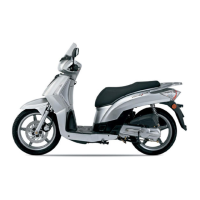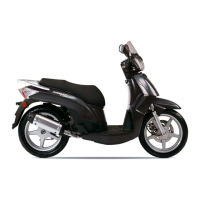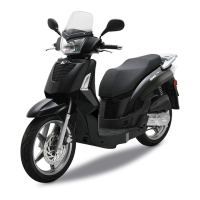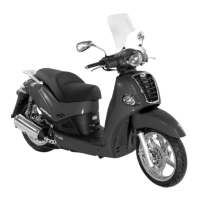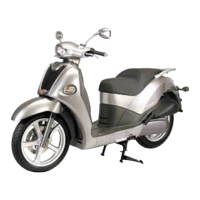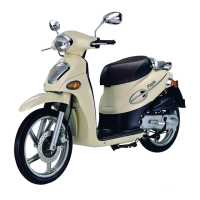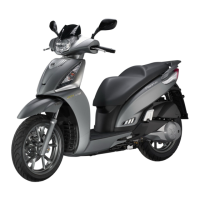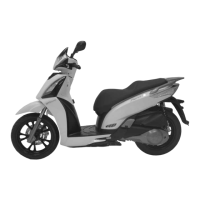
Do you have a question about the KYMCO People S 250 and is the answer not in the manual?
| Fuel System | Electronic Fuel Injection |
|---|---|
| Front Suspension | Telescopic Fork |
| Rear Suspension | Dual Shocks |
| Width | 780 mm |
| Transmission | CVT |
| Cooling System | Liquid Cooled |
| Front Brake | Disc |
| Rear Brake | Disc |
| Length | 2200 mm |
Explains important symbols like Attention, Warning, Caution, and Note for user safety.
Details the warning regarding chemicals known to cause cancer or reproductive harm.
Covers wearing a helmet, visibility, and knowing riding limits for safe operation.
Details necessary safety gear like helmets, boots, gloves, and appropriate clothing.
Specifies weight limits for the scooter, rear carrier, and under-seat storage.
Provides guidelines for balancing and securing cargo for optimal stability.
Advises on choosing and fitting accessories safely, recommending genuine parts.
Warns against altering original equipment, which can cause unsafe conditions.
Identifies major components like ignition switch, speedometer, and fuel gauge with diagrams.
Explains where to find the VIN and Engine Serial Number (ESN) for identification.
Describes the functions of the ignition switch key and how to lock the steering.
Explains the operation of right and left handlebar switches for lights, horn, and starting.
Guides on using the turn signal switch and horn button for communication.
Describes the side stand and its safety switch preventing engine operation.
Details the under-seat storage compartment and external helmet hooks.
Explains the 12V power socket and the procedure for using the main stand.
Introduces the dashboard layout, including speedometer, fuel gauge, and indicator lights.
Explains specific warning lights (coolant, oil) and digital display functions.
Provides instructions for adjusting trip meters, service reminders, and the digital clock.
Covers adjustment of rear shock absorbers and the use of passenger foot rests.
Outlines procedures for the first 600 miles to ensure engine longevity and performance.
Details new tire break-in and provides a basic troubleshooting checklist for common issues.
Lists essential checks to perform before each ride for safety and proper function.
Specific instructions for checking engine oil level, coolant level, and tire condition.
Covers fuel level inspection/refilling and checking brake fluid levels.
Details checking brake pad wear, steering smoothness, and instrument functionality.
Outlines inspection of horn, lights, turn signals, and chassis components.
Step-by-step guide on how to start the scooter's engine using the electric starter.
Basic instructions on how to mount, move, and begin riding the scooter.
Covers speed limits, braking, turning, signals, and body positioning while riding.
Provides instructions and safety tips for parking the scooter securely and locking the steering.
Explains why proper maintenance is crucial for safety, economy, and longevity.
Introduces the maintenance schedule legend and general notes for service intervals.
Details tire inspection, pressure checks, and replacement criteria.
Covers engine oil recommendations, viscosity, and the importance of quality oil.
Step-by-step guide for changing engine oil and checking the oil level.
Instructions for changing transmission fluid and inspecting the fuel system and idle speed.
Procedures for servicing the air cleaner element and replacing/gapping the spark plug.
Information on the maintenance-free battery, its charging, removal, and installation.
Guidance on checking fuses and inspecting wire/cable covers for integrity.
Instructions for adding brake fluid and general cleaning procedures for the scooter.
Advice on removing road salt, cleaning aluminum wheels, and maintaining the exhaust pipe.
Lists overall length, width, height, wheelbase, seat height, and dry weight.
Covers engine oil capacity, fuel tank size, displacement, bore/stroke, and idle speed.
Details tire sizes, suspension, brakes, ignition type, battery, and lights.
Explains the function and benefits of the Clean-Air system in reducing pollutants.
Describes crankcase, exhaust, and noise emission control systems on the scooter.
Details the warranty duration for different parts and the coverage period.
Outlines owner responsibilities for maintenance and warranty exclusions.
Explains KYMCO's liability limits and consumer legal rights related to the warranty.

